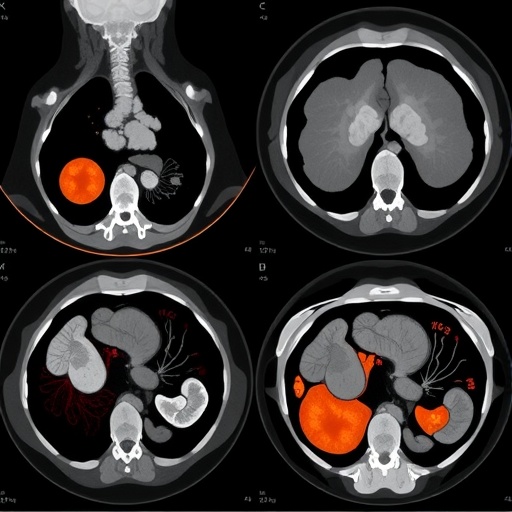In a groundbreaking study published in BMC Pediatrics, researchers T.A. Yanshet, G. Gebrezgabiher, and M. Birmeka reveal critical insights into the prevalence and risk factors of intestinal schistosomiasis among school-age children living near the Mai-Nigus irrigation dam in Tigray, northern Ethiopia. This study is not just another academic exercise; it casts a powerful spotlight on a pressing public health concern affecting vulnerable populations. The implications of this research could shape how health organizations strategize interventions in regions suffering from endemic parasitic infections.
The cross-sectional study specifically focuses on understanding how geographic and socioeconomic factors contribute to the spread of schistosomiasis, a disease caused by parasitic worms that inhabit freshwater bodies. The Mai-Nigus irrigation dam serves as a pivotal point of analysis due to its role in agricultural practices and as a potential breeding ground for snails that harbor these parasites. The findings may have lasting effects on how communities manage water resources and public health initiatives.
Children in this region are particularly at risk due to their increased likelihood of engaging in water-related activities, which expose them to contaminated water. The study’s authors gathered extensive data through surveys and medical examinations, aiming to draw correlations between schistosomiasis infections and environmental conditions. This thorough approach not only strengthens the validity of their findings but also highlights the complex interplay of ecological, socioeconomic, and behavioral factors that contribute to disease prevalence among children.
The researchers found that the prevalence of intestinal schistosomiasis in the targeted population is alarmingly high. Their analyses indicate that as many as 40% of school-age children living near the dam might be affected, raising urgent questions about the long-term health implications for these youths. Such statistics underscore the need for increased health education and preventive measures tailored specifically to younger demographics.
Furthermore, the study identifies several risk factors that contribute to the higher incidence of schistosomiasis in these communities. Among them, inadequate access to clean drinking water, poor sanitation practices, and limited health resources emerge as significant contributors to the burden of disease. These insights are invaluable for local authorities and health organizations looking to prioritize interventions aimed at the most vulnerable groups.
In particular, the research emphasizes the importance of implementing immediate public health strategies. This could include initiatives to educate communities about the risks associated with contaminated water and ways to protect themselves. Schools could play a vital role in this educational outreach, with programs tailored to teach children about hygiene and safe water practices—a crucial component in mitigating the risk of schistosomiasis and similar infections.
Additionally, the study discusses the need for improved sanitation facilities in the region. Without infrastructure that promotes safe waste disposal and proper hygiene practices, communities will remain susceptible to a range of health issues, including intestinal schistosomiasis. The researchers advocate for collaborative efforts between health agencies, governmental bodies, and community leaders to tackle these systemic issues effectively.
The study serves as a clarion call for further research into the socioeconomic factors that amplify the risks of parasitic infections. By delving deeper into the lives of those affected, researchers can identify tailored solutions that address not just the disease, but also the underlying conditions that foster it. Future studies could expand to explore how economic factors such as poverty influence health outcomes, further highlighting the need for integrated approaches to public health.
Moreover, interventions such as routine screening and treatment for at-risk populations could significantly reduce the incidence of schistosomiasis. The research team suggests that ongoing monitoring and assessment will be necessary to gauge the effectiveness of any implemented strategies. Such an approach would not only help reduce current infection rates but also provide valuable data for future health initiatives.
What makes this study particularly compelling is its potential to influence policy on a larger scale. Findings from this research could inform humanitarian organizations and international health bodies as they develop comprehensive strategies aimed at combating parasitic diseases in similar regions worldwide. By using Tigray as a case study, they highlight the pressing need for global initiatives against schistosomiasis and its devastating impacts on children’s health.
In conclusion, the findings from Yanshet and his colleagues shed light on a critical public health concern that necessitates immediate action. The prevalence and risk factors related to intestinal schistosomiasis among school-age children around the Mai-Nigus irrigation dam serve as a microcosm of broader health challenges faced by developing regions. Their research not only champions the need for enhanced awareness and preventive measures but also calls for a coordinated response to address the multifaceted risks posed by parasitic infections.
Awareness of such issues is vital, as is the promotion of further research that delves into the intersections of health, environment, and socioeconomic status. The implications of this study extend far beyond Ethiopia; they resonate with health challenges faced in similar regions worldwide, making it imperative for stakeholders to act promptly and decisively.
By addressing not only the symptoms but also the root causes of intestinal schistosomiasis, stakeholders can pave the way for a healthier future for countless children. This research inspires hope and encourages a concerted effort to combat one of the pervasive diseases affecting underprivileged communities globally. The fight against schistosomiasis begins with understanding it, and the study stands as a critical step forward in this ongoing battle against parasitic diseases.
Subject of Research: Intestinal Schistosomiasis among School-age Children
Article Title: Prevalence and risk factors of intestinal schistosomiasis among school-age children living near the Mai-Nigus irrigation dam, Tigray, northern Ethiopia: a cross-sectional study.
Article References:
Yanshet, T.A., Gebrezgabiher, G. & Birmeka, M. Prevalence and risk factors of intestinal schistosomiasis among school-age children living near the Mai-Nigus irrigation dam, Tigray, northern Ethiopia: a cross-sectional study. BMC Pediatr 25, 964 (2025). https://doi.org/10.1186/s12887-025-06354-5
Image Credits: AI Generated
DOI: https://doi.org/10.1186/s12887-025-06354-5
Keywords: Intestinal schistosomiasis, prevalence, school-age children, risk factors, Tigray, Ethiopia, public health.
Tags: community management of water resourcesfreshwater bodies and parasitic diseasesgeographic factors in disease spreadintestinal schistosomiasis in EthiopiaMai-Nigus irrigation dam impactprevalence of schistosomiasis in childrenpublic health interventions for schistosomiasisresearch on endemic parasitic infectionsrisk factors for parasitic infectionssocioeconomic influences on healthTigray school-age children healthwater contamination and schistosomiasis





